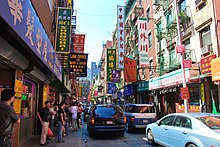New York is the most populous city in the United States. As of the 2010 United States Census, the city's population stood at a record high of 8,175,133, a 2.1% increase from the 8 million counted in 2000. Mayor Michael R. Bloomberg immediately challenged the Census Bureau’s 2010 data as representing an undercount upon release.This amounts to about 40% of the state of New York's population and a similar percentage of the metropolitan regional population. In 2006, demographers estimated that New York's population will reach between 9.2 and 9.5 million by 2030. The city's population in 2010 was 33% non-Hispanic white, 23% non-Hispanic black, and 13% Asian. Hispanics of any race represented 29% of the population, while Asians constituted the fastest growing segment of the city's population between 2000 and 2010; the non-Hispanic white population declined 3 percent, the smallest recorded decline in decades; and for the first time since the Civil War, the number of blacks declined over a decade.
Two demographic points are the city's density and ethnic diversity. In 2010, the city had a population density of 27,532 people per square mile (10,630/km²), rendering it the most densely populated of all municipalities with over 100,000 population in the United States; however, several small cities in adjacent Hudson County, New Jersey are actually more dense overall, as per the 2000 Census. Geographically co-extensive with New York County, Manhattan's population density of 66,940 people per square mile (25,846/km²) makes it the highest of any county in the United States.
New York City's population is exceptionally diverse. Throughout its history the city has been a major point of entry for immigrants; more than 12 million European immigrants passed through Ellis Island between 1892 and 1924. The term "melting pot" was first coined to describe densely populated immigrant neighborhoods on the Lower East Side.
Approximately 36% of the city's population is foreign-born. Among American cities, this proportion is higher only in Los Angeles and Miami. While the immigrant communities in those cities are dominated by a few nationalities, in New York no single country or region of origin dominates. The ten largest countries of origin for modern day immigration are the Dominican Republic, China, Jamaica, Guyana, Mexico,Ecuador, Haiti, Trinidad and Tobago, Colombia and Russia. The largest ethnic groups in New York City are African American, Italian, Jewish, and Irish. The New York region continues to be the leading metropolitan gateway for legal immigrants admitted into the United States.
The New York City metropolitan area is home to the largest Jewish community outside Israel. It is also home to nearly a quarter of the nation's Indian Americans and 15% of all Korean Americans, the largest African American community of any city in the country, and comprised as of 2008 a population of 659,596 ethnic Chinese, the largest outside of Asia. The metropolitan area is home to a self-identifying gay and bisexual community estimated at 568,903 individuals, the largest in the United States. There are also substantial Puerto Rican and Dominican populations. Another significant ethnic group is Italians, who emigrated to the city in large numbers in the early twentieth century, mainly from Sicily and other parts of southern Italy. The Irish also have a notable presence; one in 50 New Yorkers of European origin carries a distinctive genetic signature on his Y chromosome inherited from the clan of Niall of the Nine Hostages, an Irish king of the fifth century A.D. or from one of the related clans of Uí Briúin and Uí Fiachrach.
New York City has a high degree of income disparity. In 2005 the median household income in the wealthiest census tract was $188,697, while in the poorest it was $9,320. The disparity is driven by wage growth in high income brackets, while wages have stagnated for middle and lower income brackets. In 2006 the average weekly wage in Manhattan was $1,453, the highest and fastest growing among the largest counties in the United States. The borough is also experiencing a baby boom that is unique among American cities. Since 2000, the number of children under age 5 living in Manhattan grew by more than 32%.


No comments:
Post a Comment